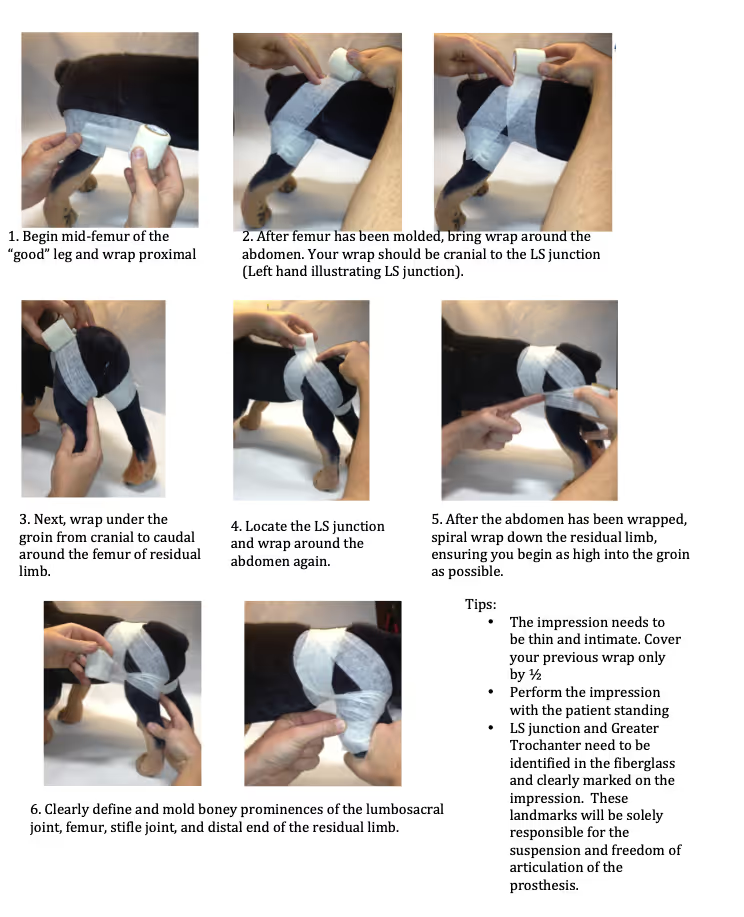Standard of Practice Chevy Prosthetic Impressions
You will need:
GATHERDOCUMENTS AND IMPRESSION MATERIALS:
⦁ Patient Information Document (included in kit or can be found on website)
⦁ Measurement form
⦁ Glad Press’n Seal plastic wrap (must use this for greatest success)
⦁ Cut strip (can substitute ¼” surgical tubing or drip line)
⦁ Hook blade (available at local hardware store)
⦁ Tape
⦁ Bandage scissors
⦁ Fabric measuring tape
⦁ Permanent marker
⦁ Gloves
⦁ Bowl of cold water
⦁ Fiberglass non-flexible casting tape:
⦁ Recommend 2” for Labrador size; 1.5” for smaller breeds.
⦁ Do not use larger than 2” except for equine size animals.
Step by step instructions:
STEP-BY-STEP IMPRESSION INSTRUCTIONS:
1) Positioning:
a. Patient in standing.
b. Align limb in desired position/angle.
c. Ok to align limb for standing position or in a therapeutic alignment.
2) Waterproof barrier – use Glad Press’n Seal wrap (in place of stockingette). Start by wrapping the femur of the “good” leg, entire abdomen, and the entire residual limb including the bottom surface of the stump.
3) Cut strip – Position cut strip with groove facing on lateral aspect of the distal most portion of affected limb. Ensure the cut strip presents beyond the end of the residual limb and extends proximal of the thigh.
4) Prep fiberglass casting material – use cold water. Don’t open casting material pouch until you’re ready to use it.
5) Apply fiberglass:
a. Apply the casting material mid-femur of the “good” leg and spiral wrap proximal.
b. Only overlap ½ of the previous layer, wrap up to groin and then around the abdomen. See step#2 on photo instructions.
c. Next, wrap under the groin of the affected limb, cranial to caudal, and then back around abdomen. The LS junction will be the landmark for your location on the back.
d. Begin to spiral wrap down the affected limb, ensuring you begin as high into the groin as possible.
e. Continue wrapping down the affected limb until the end of the stump has been included. Be sure to mold the stump as intimate as possible, as this is critical for a proper fit.
f. Do NOT wrap back up the limb. We need a thin impression (unlike a cast) of the limb.
g. Cut off excess fiberglass material while it is wet.
6) Setting the impression:
a. Hold stifle joint in alignment in natural standing angle.
b. Massage the fiberglass material with your hands to achieve the following results:
i. Ensure the tape layers bond.
ii. Smooth out wrinkles and expose the contours and landmarks/anatomy of the limb.
1. Patella.
2. Greater and lesser tibial tuberosities.
3. Greater trochanter.
4. LS junction.
5. Stifle joint center.
6. Distal tip and plantar surface of stump.
7) Mark the impression – Use a permanent marker to identify landmarks once the impression has hardened:
a. Distal end of stump.
b. Fibular head.
c. Tibial crest (attachment site for patella tendon).
d. Patient name.
8) Remove impression – starting at the top/proximal edge, use bandage scissors to cut down to cut strip, then use hook blade utility knife and follow the cut strip groove. Remove Press’n Seal with bandage scissors.
9) Tape impression back together – Immediately tape the cast back together using any tape available.
10) Ship impression to OrthoPets – Use sturdy box appropriately sized to fit impression without too little or excess space. Light padding material can be used.

How can we help?
Our team will assist you to get started.
